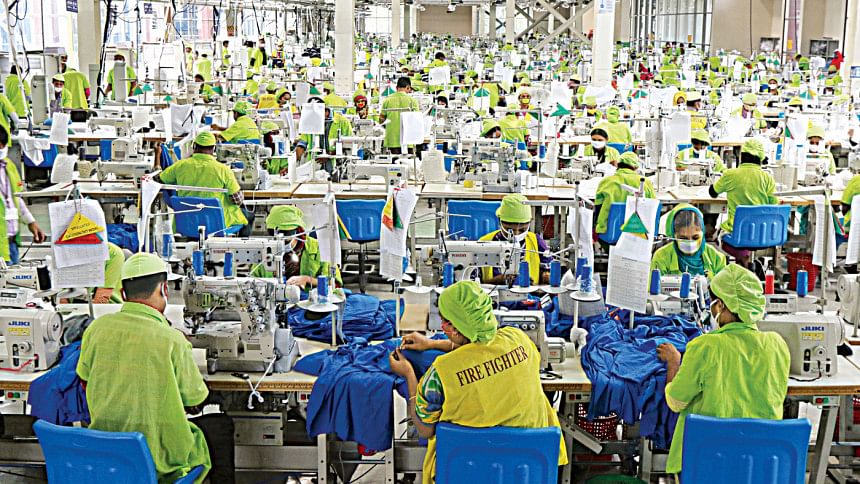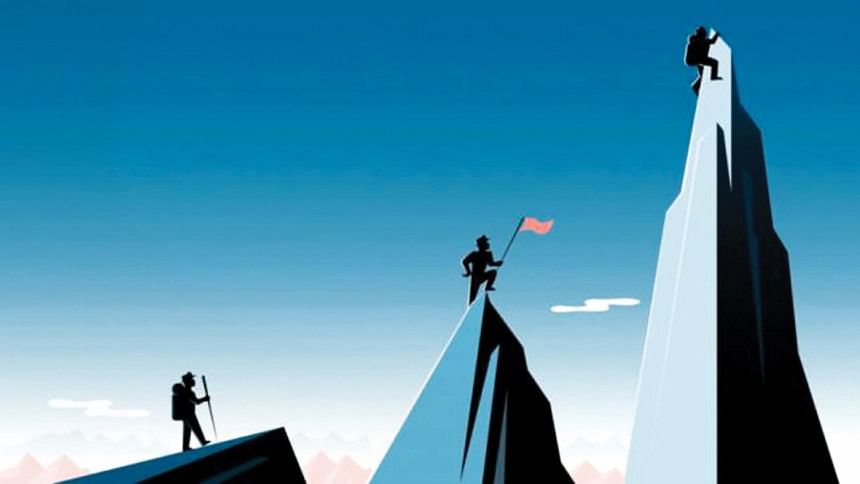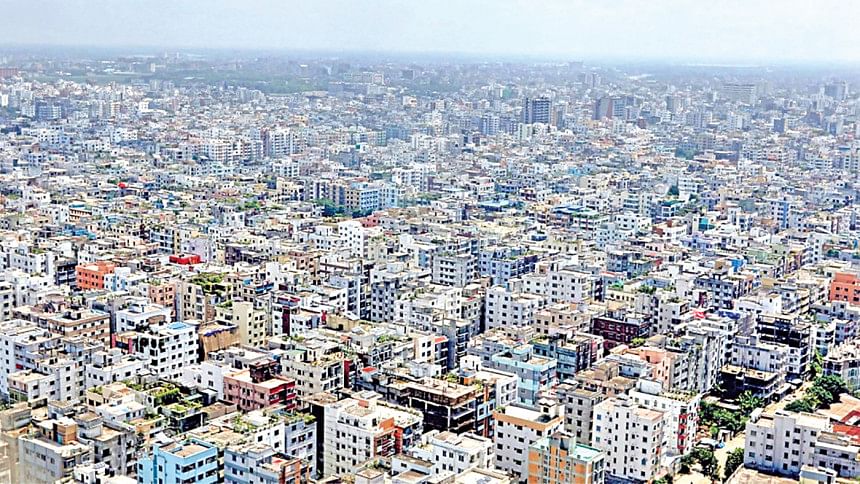Bangladesh as a ‘developed country’: ‘Graduating’ imperatives

"Graduation" has become a Bangladeshi buzzword. Journalists, scholars, and technocrats were working on that term even before November 24, 2021. On that day, the United Nations (UN) General Assembly green-signalled a possible exit from the "least developed country" (LDC) to join the "developing" list from 2026. At stake is how and when to fine-tune the goals and what tools to use. Climbing any tree, such as this, profits from knowing the size, shape, and substance of the forest it belongs to. With economics as the necessary condition for this "graduation", non-economic sectors also demanding graduation see it as only one sufficient condition.
"Graduation" resonates with two other current Bangladeshi buzzwords: "Vision 2041" predicting a "developed country" by the 2040s; and the recently acquired "middle-income country" (MIC) identity. All of these entail progr
ILLUSTRATION: COLLECTED
ession. Still celebrating its 50th Birth Anniversary, Bangladesh needs that elevation more desperately now than in 1972, if not to deliver even loftier goals, then to give the bedrock Sonar Bangla mindset a fuller glow. Though their goals overlap, "graduation," "middle income country," and "Vision 2041" just happen to be slanted differently. Nonetheless, every one of their goals is possible and remains consistent with each other, but taking them for granted rocks the growth boat.
Discussion can begin with the November 24, 2021 UN Resolution (A/RES/76/8). How it delayed Bangladesh's preparatory "graduation" phase from the typical three-year benchmark (2024) to five-years (2026), indicates why nothing can be taken for granted and why bridging lapses and battling constraints may be better than benign neglect: prescribed goals will not fall from the sky; they must be built from the ground. Along with Lao Republic and Myanmar, Bangladesh was found eligible for "graduation" in its first triennial review (at which point even lesser affluent countries like Nepal and Timor-Leste completed their second triennial reviews). Only after clearing the second triennial review can Bangladesh "graduate." Bangladesh's capacity to "graduate" was what led the UN Economic and Social Council (ECOSOC) to recommend the country, based on a thorough review of its Committee for Development Policy (CDP).
CDP clearance must satisfy three criteria: a per capita gross national income (GNI) of USD 1,222; a score of 66 or higher on the human assets index (HAI); and a 32 score, or below, on the economic vulnerability index (EVI). At least two of these must be satisfied in both triennial reviews to "graduate." Since having a GNI per capita twice the minimum relaxes both other criteria, the implied "top-down" growth only fattens problems that a "bottom-up" approach, by fulfilling the two other criteria, largely thwarts.
These are not spontaneously or instantaneously achieved scores. EVI scores are based upon long-term monitoring of nutrition, health, education, and adult literacy rates, whereas GNI measurements assess population, remoteness, merchandise export concentration, and the share of agriculture, forestry and fisheries. Other factors also sneak in: the proportion of people living in low-elevated coastal areas, degree of instability in trade performances, natural disasters, and farm output.
Spending years in direct or indirect preparation is not enough. Collaborating with the UN Resident Coordination Office (UNCOR) in each country helps shape the "national smooth transaction strategy." Since CDP monitoring is assiduous, persistent, and thorough, even non-tangible features enter the calculation: the government's proclivity, for instance, as well as such sudden crisis-laden outbursts as Covid-19 impacts and recovery plans.

Unfolding statuses of 17 sustainable development goals (SDGs) ice the "graduation" cake. Some bear directly on "graduation": SDG 1 on "no poverty", 2 on "hunger", 3 on "good health and wellbeing", 5 on "gender-equality", as well as 6-8 "on clean water, sanitation, clean energy, and decency of work"; while SDG 10 on "reducing inequalities", and 11-15 on "sustainability and climate-change corrections" demand increasing urgencies.
Three other "graduation" catalysts (SDG 4 on "quality education"; SDG 16 on "institutional maturity and fairness"; and SDG 17 on "partnership building"), alert us to the unwritten need: marrying LDC economic "graduation" with non-economic "graduations".
Clarifying the ever-evolving and ambiguously-used development term is a start. Though SDG yardsticks measure development today, they were not previously applied to gauge the growth of today's "developed countries", in fact, were outside any equation until after World War II. The United States exemplifies. It progressed from a "traditional agrarian society" in the 18th Century into a "fully developed country" by the 20th Century without any SDG tabulation. Yet how US-type of advanced countries have leveraged developmental benchmarks when applied elsewhere opens other questions. SDG concerns were automatically and independently tackled as part of US modernisation or state-building (as opposed to nation-building, which assumes a dominant nationality exists—a missing blank in 18th-19th Century United States). No SDG supervision was needed in a country increasingly needing it today, if more frequent desertification and forest-fires are any guide; and, of course, the absence of any climate-change imperative stands out. They have returned to complicate post-War War II "graduation."
Autonomous and independent US modernisation meshed with loosely applied development to formulate "stages" of development. For example, Walt Whitman Rostow, who formalised this in 1960, hardly acknowledged the ECOSOC/CDP second and third criteria and barely paid lip-service to the first. Using "economic growth" indicators, he proposed five stages, from the "traditional agrarian" to the "high mass consumption" stage, with "pre-take-off", "take-off", and "maturity" in between, and in that order. They clarify Bangladesh's "graduation" chores and trajectory more clearly than CDP "graduation" tasks.
"RMG" was Bangladesh's prime buzzword before "graduation" in its development lore. How RMG exports fuelled Bangladesh's transformation from a "bottomless pit" to LDC membership for more than three decades leaves too deep imprints to easily be replaced. Yet industrial diversification is today's clarion call to fulfil CDP requirements and SDG expectations.
Viewed through Rostow's theory, Bangladesh's RMG sector plucked the country out of the "traditional agrarian" first stage: once three-quarters of the population lived in the countryside (the 1970s), today merely one-third. RMG jobs sparked urbanisation and the "pre-take-off" stage (though microfinance, remittances from migrant workers, rural poverty, and environmental problems chipped in handsomely), and took the country into the "take-off" stage.

Economic diversification is critical to converting the "take-off" stage into "maturity": "Vision 2041" depends upon it. Neophyte Bangladesh launched this journey without amply coordinating the transformational (and the Rostow-based theoretical) dimension/s. Raising the ante today from low-wage RMG production to slightly higher-wage motor-cycle/automobile/shipbuilding feeds relevant skill "graduation" without UN/ECOSOC/CDP scrutiny. It characterises Bangladesh entering the "take-off" peak. When the country shifts from these high-skilled physical work into intellectually-driven service skills (manual work, for example, becoming automated), Bangladesh will have stepped into the "maturity" stage and, even higher, "high mass-consumption" would prevail.
Digital Bangladesh, represents a grand leap from RMG infrastructures and institutions, was made in December 2008 for these two stages. It must be quickly "thickened" with the right kind of both skills and consumers. This is where SDG 4 (on "education") counts. Preparing IT (information technological) and other intellect-based "graduates", then marrying them off to LDC economic "graduation" satisfies every customer: climbing economic growth keeps Bangladesh citizens purring, acknowledges theoretically-minded scholars, like Rostow, and defuses ECOSOC/CDP-type external watchdogs. How Bangladesh delivers economically in 20-odd years to become a "developed country" will now depend, not on money, but on successful educational, social, and other such sectoral transformations. Letting go of a half-century addiction to RMG habits, mindsets, and structures will be a tough pill to swallow, suggesting a 20-year "Vision 2041" timeframe to be too tight to build the infrastructures, institutions, and instincts of successive industries/sectors: under intellectual skills they evolve far slower than physical skills (though intellectual skills, or software, emerge far faster than physical hardware skills).
Sociological concerns have been RMG handmaidens: low-wages, and the Rana Plaza and Tazreen factory incidents show this. Does the country today boast more safety-guards against fire-hazards in both RMG and non-RMG factories than before; and have the RMG worker-skills moved sufficiently up from the manual level to the automated over the past half-century to augment any upward shift from a "least developed country" to a "developing" counterpart, and if so, then to the shift from a "developing country" to a "developed"? More bluntly, can Bangladesh survive without low-wage production? Or more personally, can the typical "developed country" household survive without a cook, cleaner, chauffeur, or other staff that has remained a mainstay of all stages thus far? Has the country begun formulating a social security framework to cater to those at the margin; or soften Covid-type crises right across the social spectrum; or for its citizens to assume a minimum degree of healthcare, no matter what?
Every "developed country" needs Main Street footprints to impact ordinary pedestrians. Have the expanding RMG export income (currently more than USD 30 billion annually, while targeting USD 50 billion) and foreign exchange reserves (currently over USD 45 billion annually), trickled down to Main Street—through meaningful jobs, expanded purchasing power, consumption shifting from basics towards luxury, and so forth? The proportion of net attention paid to these sectors will structure and institutionalise the country, thus breeding the instincts: how much education one has, what that education translates into for a consumer (that is, what one spends on), and if the slow and steady replacement of paisa-conserving plebeian attitudes yield to noblesse oblige gestures, indeed, in all mannerisms.
Other SDC platforms echo similar tones. There is no way SDG 16 (on "institutional growth and fairness") can be satisfactorily fulfilled without advancing SDG 17 (on "partnership-building"). With only one free-trade agreement (FTA) in the kitty, Bangladesh desperately needs more to climb any ladder. Ongoing negotiations with Southeast Asian countries must quickly become the spark of a global FTA flurry—all dependent upon how rapidly we relax our protectionist infrastructures, institutions, and instincts. Balancing India or China from dominating our economy should become less the concern than strengthening the very kernels of partnerships: trust, reciprocity, fairness, mutuality, and so forth, in every direction. Having only just scraped the surface of world-wide bilateral trade and investment opportunities, we are beginning to understand how institutions strengthen as much with these as the partnerships they construct, and why the new infrastructures and institutions angle reshape instincts differently.
Bangladesh's Covid-19 responses and recovery explain why. How they helped the country shift from face-to-face education to online counterparts speaks to the resiliency levels of our schools, colleges, and universities. Private universities adjusted faster than public universities, but overall, Bangladesh is not deeply entrenched in knowledge-building arts/sciences to notch success: poor connections, unpredictable power-supply, and a paucity of services handicap rural students. These threaten SDG equalising efforts and weaken the second and third CDP pre-requisites, while also leaving the new infrastructures, institutions, and instincts too raw to survive this first round. Nonetheless, we were exposed to internet-based Third Revolution and artificial intelligence (AI)-based Fourth Industrial Revolution, demonstrating our capacity (not our mastery) to shift from the physical-based First and Second industrial revolutions to the intellectual domain. With two decades or so for full "Vision 2014" translation, we barely have the time to make it.
Lapses like these could be listed ad infinitum, but the underlying messages of building robust practices and mindsets, then aligning them abroad through collaboration could not have been more timely.
Inside the country we will find (and have no choice but to resolve) the same rich-poor divisions development hopes to minimise between countries: the symbolic Gulshan-Gulistan schism can only be restructured if the instincts drive us to do so, such that future Bangladeshi metropolitans in the 2040s look more like Gulshan than Gulistan and the countryside escapes returning to a zamindari system, this time not under ancient aristocrats but newly-minted bourgeoisie. Only with multiple marriages of "graduating" processes can the five-year LDC transformation supply the infrastructures, institutions, and instincts to worthily reflect the mindset and reality of a "developed country." Few, if any, "less developed country" can be better poised to deliver than Bangladesh, if the right buttons are pushed.
Imtiaz A Hussain is professor, Department of Global Studies & Governance Independent University, Bangladesh.

 For all latest news, follow The Daily Star's Google News channel.
For all latest news, follow The Daily Star's Google News channel. 



Comments